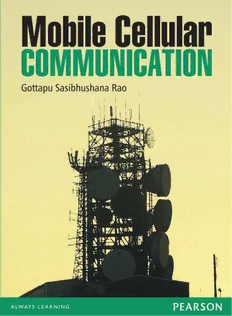Table Of ContentMobile Cellular
Communication
This page is intentionally left blank.
Mobile Cellular
Communication
Gottapu Sasibhushana Rao
Professor and Head
Department of Electronics and Communication Engineering
Andhra University College of Engineering
Visakhapatnam
Copyright © 2013 Dorling Kindersley (India) Pvt. Ltd.
Licensees of Pearson Education in South Asia
No part of this eBook may be used or reproduced in any manner whatsoever without
the publisher’s prior written consent.
This eBook may or may not include all assets that were part of the print version. The
publisher reserves the right to remove any material present in this eBook at any time.
ISBN 9788131773611
eISBN xxxxxxxxxxxxx
Head Office: A-8(A), Sector 62, Knowledge Boulevard, 7th Floor, NOIDA 201 309, India
Registered Office: 11 Local Shopping Centre, Panchsheel Park, New Delhi 110 017, India
Contents
About the Author xix
Preface xxi
1 Introduction to Mobile and Cellular Communication Systems 1
1.1 Introduction 1
1.2 Generations of wireless mobile systems 2
1.3 Cellular geometry 7
1.4 Introduction to cellular concept 8
1.5 Principle of operation of a cellular mobile system 14
1.6 Call transfer operation from one mobile phone to another 18
1.7 Multiple access schemes 21
1.8 Analogue and digital cellular mobile systems 21
1.9 Existing mobile communication technologies and current status 26
1.10 Summary 32
Review questions 33
Objective type questions and answers 34
Open book questions 35
Further reading 35
2 Cellular Geometry, Frequency Reuse, Cell Splitting, and Sectoring 37
2.1 Introduction 37
2.2 Cellular geometry 38
2.3 Frequency reuse 42
2.4 Improving coverage and capacity in cellular systems 57
2.5 Cell splitting 57
2.6 Sectoring 59
2.7 Range extension by the use of repeaters 62
2.8 Microcell zone concept 63
2.9 Picocell zone concept 64
2.10 Summary 65
vi Contents
Review questions 69
Objective type questions and answers 70
True/False 71
Open book questions 71
Key equations 72
Further reading 72
3 Elements of Cellular Radio System Design 73
3.1 Introduction 73
3.2 Concept of frequency reuse channels 73
3.3 Co-channel interference 74
3.4 Desired C/I from normal case in an omnidirectional
antenna system 79
3.5 Cellular system design in worst-case scenario with an
omnidirectional antenna 80
3.6 Cell splitting 83
3.7 Challenges in cell splitting 85
3.8 Consideration of the components of the cellular system 89
3.9 Summary 90
Review questions 90
Objective type questions and answers 91
Open book questions 92
Key equations 92
Further reading 93
4 Interference 95
4.1 Introduction 95
4.2 Types of interferences 95
4.3 Co-channel interference areas in a system 96
4.4 Estimation of co-channel interference level 98
4.5 Real-time co-channel interference measurement 102
4.6 Diversity receiver 103
4.7 Non-co-channel interference 104
4.8 Estimation of adjacent-channel interference levels 107
4.9 Summary 108
Review questions 110
Objective type questions and answers 110
Open book questions 111
Key equations 111
Further reading 112
Contents vii
5 Co-Channel Interference Models and Reduction 113
5.1 Introduction 113
5.2 Geographical and statistical models 113
5.3 Interference models 115
5.4 Reduction of co-channel interference 123
5.5 Summary 125
Review questions 127
Objective type questions and answers 127
Open book questions 128
Key equations 128
Further reading 128
6 Teletraffi c Engineering, Trunking, GoS,
and Operational Techniques 129
6.1 Introduction 129
6.2 Objectives of teletraffi c engineering 129
6.3 Concepts of trunking and blocking 130
6.4 Call capacity 131
6.5 Grade of service (GoS) 133
6.6 Blocking probability formulas 134
6.7 Operational techniques and technologies 140
6.8 Summary 146
Review questions 148
Objective type questions and answers 148
Open book questions 149
Key equations 150
Further reading 150
7 Basic Antenna Theory 151
7.1 Introduction 151
7.2 Basics of antennas 152
7.3 Other important antenna parameters 164
7.4 Antenna arrays 170
7.5 Summary 176
Review questions 177
Exercise problems 178
Objective type questions and answers 178
Open book questions 179
Key equations 179
Further reading 180
viii Contents
8 Mobile Antennas 183
8.1 Introduction 183
8.2 Antenna fundamentals 186
8.3 Types of antennas 188
8.4 Mean effective gain 200
8.5 Human body interactions and specifi c absorption rate 201
8.6 Mobile satellite antennas 201
8.7 Summary 202
Review questions 203
Objective type questions and answers 203
Open book questions 204
Key equations 204
Further reading 204
9 Cell-Site Antennas for Mobile Communication 205
9.1 Introduction 205
9.2 Cell-site antennas 206
9.3 Design of directional antennas 214
9.4 Macrocell antenna 217
9.5 Microcell antennas 220
9.6 Picocell antennas 222
9.7 Femtocell 223
9.8 Space diversity antennas 224
9.9 Base station systems 226
9.10 Effects of cell-site antenna parameters 229
9.11 Summary 230
Review questions 232
Exercise problems 232
Objective type questions and answers 233
Open book questions 233
Key equations 234
Further reading 234
10 Mobile Radio Propagation and Modeling 235
10.1 Introduction 235
10.2 Basics of mobile radio propagation 235
10.3 Free-space propagation model 237
10.4 Link budget design 246
10.5 Propagation models 247
10.6 Types of small-scale fading 255
10.7 Statistical models for multipath propagation 260
Contents ix
10.8 Summary 265
Review questions 266
Exercise problems 266
Objective type questions and answers 267
Open book questions 268
Key equations 268
Further reading 269
11 Cell Coverage for Signal and Traffi c 271
11.1 Introduction 271
11.2 Point-to-point model 271
11.3 Propagation over water or fl at open area 273
11.4 Foliage loss 274
11.5 Cell-site antenna heights and signal coverage cells 275
11.6 Near and long-distance propagation 277
11.7 Summary 280
Review questions 281
Objective type questions and answers 281
Open book questions 282
Key equations 282
Further reading 283
12 Frequency Management and Channel Assignment 285
12.1 Introduction 285
12.2 Numbering the radio channels 285
12.3 Set-up channels 288
12.4 Traffi c and channel assignment 288
12.5 Channel assignment algorithms 290
12.6 Simulation process and results 291
12.7 Summary 294
Review questions 296
Objective type questions and answers 297
Open book questions 298
Further reading 299
13 Modulation Techniques 301
13.1 Introduction 301
13.2 Frequency modulation 302
13.3 FM detection techniques 303
13.4 Digital modulation 305

